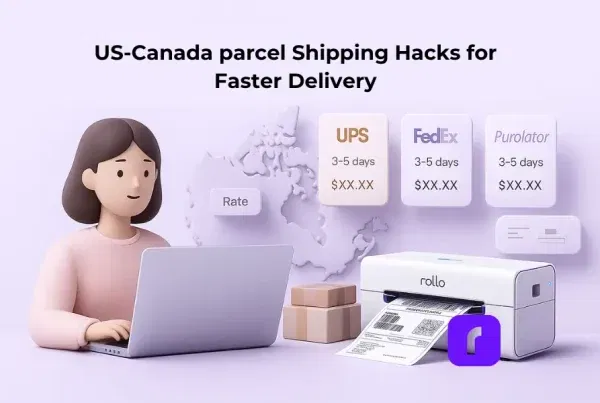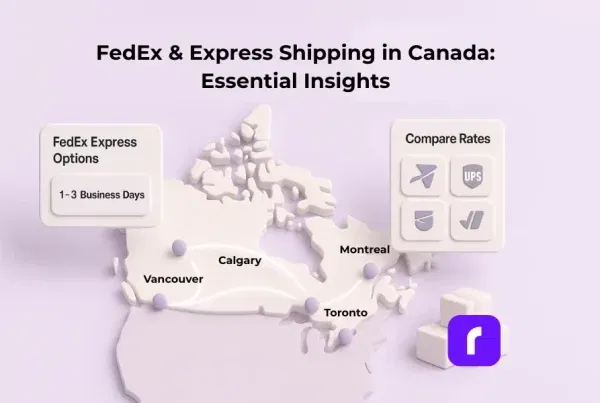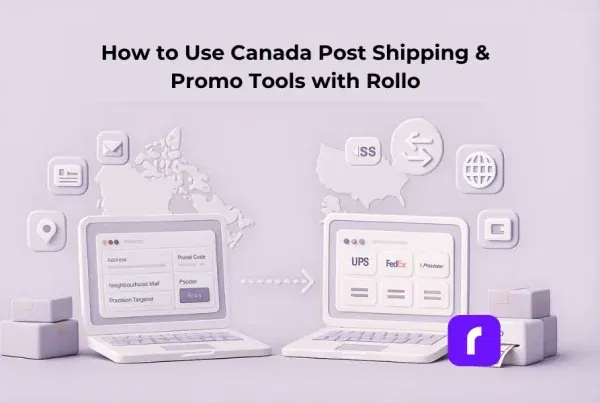Running an online store is thrilling—until that thrill turns into a frantic search for a missing package or a string of “Where’s my order?” emails. Order management—the way you track, process, and ship every sale, from order to delivery—can make or break the customer experience. Nail it, and buyers rave about your reliability. Fumble it, and they head to the competition.
This guide walks you through ten practical tips any small‑to‑medium business can use to tighten workflows, speed up fulfillment, and keep customers smiling. We’ll also show how tools like Rollo Ship and the Rollo Wireless Printer turn theory into real‑world time savings.
Main Takeaways
Why Order Management Is a Make‑or‑Break Factor for SMBs

Picture a relay race. Each leg—order capture, payment, picking, packing, shipping—depends on the last. If one runner stumbles, every hand‑off slows down. In commerce, that stumble often shows up as oversold inventory, mislabeled parcels, or a warehouse worker hunting for the right SKU. An effective order management process keeps the baton moving smoothly:
- 👀 Visibility. Everyone—from sales to fulfillment—sees the same, real‑time order status.
- ✅ Accuracy. Automation catches typos, duplicate entries, or label errors before they snowball.
- ⚡ Speed. Clear workflows shrink pick‑pack‑ship times, lowering costs and meeting modern customer expectations for fast delivery.
When these pieces click, you ship faster, spend less, and create a loop of repeat business. Let’s dive into the ten tips that get you there.
Ready to Master Order Management?
Rollo Ship unites every order, channel, and label in one smart dashboard—then fires your Rollo Wireless Printer with a single click.
Sync sales automatically, slash errors, print discounted labels on the spot, and watch your fulfillment go from hectic to hassle‑free.
10 Tips to Speed Up Order Management

Looking for ways to streamline your fulfillment workflow? These 10 strategies help businesses move faster and smarter. If you’re using an order management software platform like Rollo Ship, most of these tips become automatic—or just a few clicks away.
1. Automate Order Entry to Reduce Human Error
Copy‑pasting order details may feel harmless at ten orders a day, but it becomes risky guesswork at fifty. An automated system pulls data directly from your online store or marketplace, verifies addresses, and flags incomplete information before it reaches the warehouse. That single workflow swap eliminates typos, cuts down on returns, and frees your team for higher‑value tasks like customer outreach.
2. Sync Inventory Across All Sales Channels
Selling on Shopify, eBay, and your own site? Great for revenue—messy for stock counts. Use a centralized inventory management tool that updates levels the moment an item sells, no matter the channel. Real‑time sync prevents overselling, protects your reputation, and enables accurate “back in stock” notifications that keep buyers informed instead of frustrated.

3. Use Real‑Time Order Tracking to Improve Visibility
Customers track pizza deliveries minute‑by‑minute; they expect the same clarity from online stores. Real‑time tracking dashboards show order status to both staff and shoppers. Internally, managers spot bottlenecks early; externally, buyers get peace of mind without emailing support. The result? Fewer “just checking in” messages and more five‑star reviews.
4. Integrate Reliable Ecommerce Order Management Software
eCommerce order management software acts as the central hub for your entire fulfillment workflow. It seamlessly connects your online store platforms—like Shopify, WooCommerce, or Amazon—with essential tools such as payment processors, shipping carriers, and customer support systems. The best solutions offer real-time tracking, inventory syncing, and automation features like auto-routing orders to the nearest warehouse or assigning the lowest-cost carrier for international shipments.
By centralizing operations across multiple sales channels, ecommerce order management software eliminates manual data entry, reduces fulfillment errors, and streamlines the entire order processing cycle. Whether you’re managing returns, handling high order volume, or scaling to new marketplaces, this type of software helps keep your logistics, inventory, and customer experience aligned—all from one intuitive dashboard.
For a deeper look at how an all‑in‑one ecommerce order management software simplifies shipping for growing brands, explore our guide to Rollo Ship shipping software for small business.

5. Standardize Your Fulfillment Process
If every employee packs boxes “their way,” chaos creeps in. Draft a simple playbook that covers picking sequences, packing materials, and quality checks. For example, mandate that fragile items always get a scan before sealing the carton. Include a clearly formatted packing slip with every box—here’s why a packing slip is critical to error‑free order management. Consistency trims decision time on the floor and makes it easier to train seasonal staff without reinventing the wheel.
6. Print Shipping Labels Wirelessly for Faster Output
Walking to a central printer hundreds of times a day is a hidden time sink. A wireless thermal printer—like the Rollo Wireless Printer—lets packers print labels at the station where they’re already boxing orders. No ink, no jams, just crisp 4×6 labels in a second flat. Cutting a few seconds per order adds up to hours saved each week.
Want a full checklist of tech that trims costs and speeds up parcel prep? Check out our roundup of small‑business shipping tools that pair perfectly with an efficient order management setup.
Streamline your order management from packing to print—go wireless
with Rollo and simplify every label, every time.

7. Centralize Returns Management
Returns happen—especially in apparel and electronics. Treat them as part of the order management lifecycle rather than an afterthought. A branded returns portal creates pre‑approved labels, feeds tracking numbers back into your OMS, and updates inventory the moment an item is scanned back in. That closed loop keeps stock counts accurate and customers confident they’ll receive refunds promptly.
8. Train Your Team on Customer Communication Tools
Automation is great, but customers still value human updates when something goes wrong. Equip agents with quick‑reply templates inside your help desk and give warehouse leads permission to trigger delay notifications. Clear, empathetic messages turn potential disappointments into moments of trust—and trust drives repeat business.

9. Forecast Demand Using Sales and Inventory Data
Running out of best‑sellers in Q4 hurts more than any shipping fee. Use historic sales data and traffic trends to predict surges. Most OMS platforms include basic forecasting; pairing that with your marketing calendar tells purchasing teams exactly when to reorder. Keeping safety stock aligned with demand means you spend money on products that move, not on warehouse shelf space.
10. Monitor the Entire Supply Chain End‑to‑End
Suppliers, 3PLs, last‑mile carriers—all affect the final delivery. Set up dashboards or automated alerts that surface delays anywhere in the entire supply chain. Early warnings give you time to reroute shipments or offer proactive discounts, which preserves customer goodwill even when problems lie beyond your four walls.
How Rollo Ship’s Order Management Software Streamlines Fulfillment

Brilliant workflows need reliable tools. Rollo Ship is a powerful order management software that integrates with major ecommerce platforms, marketplaces, and carriers, pulling all orders into one clean dashboard. You can batch‑print labels, compare carrier rates, and sync tracking numbers back to customers with a single click.
Pair that software with the Rollo Wireless Printer and labels spool out in seconds—no ink, no cables, no calibration headaches. Together, this combination of order management software and wireless label printing transforms the slowest part of fulfillment into a one‑touch operation:
- 📥 Orders import automatically.
- 🚚 The system suggests the cheapest carrier based on weight, destination, and service level.
- 🖨️ Staff print flawless labels at their station, seal boxes, and move to the next order.
Less walking, fewer errors, faster shipping—exactly what growing businesses need.
For a deeper dive, visit the Rollo Ship overview or check out our guide on the cheapest way to ship a package.
Final Words
Effective order management isn’t a luxury; it’s the engine that keeps customers happy and profits healthy. Automate where you can, standardize where you must, and lean on tools that remove friction rather than add complexity. Whether you adopt one tip or all ten, every small improvement compounds into faster fulfillment times and better customer reviews.
Ready to put these tips into action? Try Rollo Ship free and see how simple, integrated workflows—paired with a Rollo Wireless Printer—turn chaotic order days into smooth, satisfying sprints.
Follow Rollo on:
Frequently Asked Questions About Order Management
📌 Q: What is the order management process and where does it begin?
💭 A: The order management process begins the moment a customer places an order on your online store or any other sales channel. From that first order capture or order entry, the request moves through payment approval, pick‑pack‑ship, and finally to delivery, where the customer receives the package. Each stage—sometimes called the order management lifecycle or order management cycle—updates the order status so your team maintains complete visibility across the end‑to‑end process. When every hand‑off is clear, you shrink processing time and set the stage for higher customer satisfaction.
📌 Q: How can the right order management system cut human error and speed up fulfillment?
💭 A: An effective order management system (OMS)—or any modern order management software—automates repetitive manual processes like address checks, SKU matching, and label creation. The automated system verifies each order detail, flags mismatches, and pushes real‑time data to your warehouse. That means fewer mistakes, faster picks, and smarter, data‑driven decisions about stock levels. Look for an OMS that integrates with all your storefronts, offers complete visibility, and scales as your customer base expands—that’s the hallmark of the best order management system for growing brands.
📌 Q: Where does the order fulfillment process fit into customer expectations?
💭 A: The fulfillment process—pulling items, packaging, labeling, and shipping—sits at the heart of the complete order fulfillment process. Customers expect speed, accuracy, and a convenient customer experience. A streamlined hand‑off from OMS to warehouse ensures on‑time dispatch, lowers shipping costs, and delivers a truly cohesive customer experience. Nail this flow and you improve customer satisfaction, encourage repeat business, and boost lifetime value.
📌 Q: How can small businesses cut shipping costs while selling on multiple channels?
💭 A: Start by syncing inventory management across all platforms so you never oversell or split shipments unnecessarily. Then use an OMS (like Rollo Ship) that compares carrier rates, prints labels in seconds, and optimizes routes through your entire supply chain. Accurate, channel‑wide counts let you forecast demand better, consolidate picks in key fulfillment locations, and choose the cheapest service that still meets delivery promises—great for margins and business growth.
📌 Q: Why is accurate inventory status so important to efficient order processing?
💭 A: Real‑time inventory availability tells your system what can ship now versus what needs replenishment. When stock data lags, you risk backorders, refunds, and angry emails. Live counts let each sales team member see the same numbers, keep managing orders smooth, and eliminate the guesswork that leads to human error. Up‑to‑date inventory also feeds forecasting tools, preventing both over‑buying and out‑of‑stocks.
📌 Q: How do returns fit into an effective order management process?
💭 A: Smooth returns management keeps the entire process intact by looping returned items back into inventory, updating the order management system, and triggering refunds or store credits immediately. Automating return labels and scanning items at fulfillment centers ensures speed and accountability, safeguarding loyalty while protecting profit.
📌 Q: Can Rollo Ship handle order management challenges as my volume grows?
💭 A: Yes. Rollo Ship is built for efficient order management across multiple channels. The platform automatically imports new customer orders, updates order status in real time, and batches labels to slash clicks. As your order management system makes more data available, you gain complete visibility into stock, carriers, and costs—no matter the customer’s location or the size of your catalog.
📌 Q: What is ecommerce order management software?
💭 A: eCommerce order management software is a digital solution that helps businesses manage the entire order lifecycle—from purchase to delivery. It automates tasks like pulling order data, verifying shipping addresses, updating inventory, and printing labels. Most platforms integrate with popular stores like Shopify, eBay, and Amazon, making it easier to manage multi-channel sales without manual entry or delays.
📌 Q: How can I use a shipping app to improve order fulfillment?
💭 A: A shipping app improves order fulfillment by automating repetitive tasks and unifying all your sales channels into one workflow. Here are key ways it helps:
– 🚀 Streamline Shipping Processes – generate labels automatically, compare carrier rates, and batch similar orders to ship faster.
– 📦 Optimize Inventory Management – track real-time stock levels, set up low-stock alerts, and sync counts across platforms.
– 🏬 Enhance Warehouse Operations – use barcode scanning, optimized storage, and auto-replenishment for smoother picking and packing.
– 👥 Improve Customer Experience – provide real-time tracking links and automated delivery notifications to reduce “Where’s my order?” messages.
– 🔄 Integrate & Automate – pull in orders from Shopify, Amazon, or eBay, and manage returns instantly in the same dashboard.
With Rollo Ship, these features come built in—so you can manage orders, print flawless labels with a Rollo Wireless Printer, and keep customers happy without extra third-party apps.


